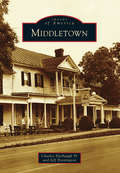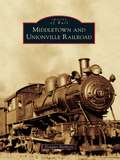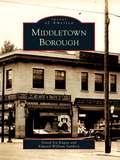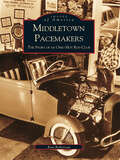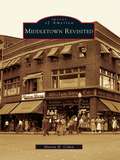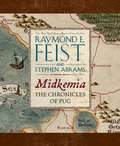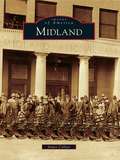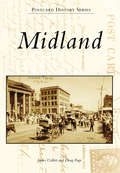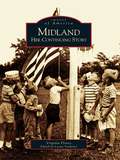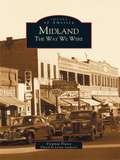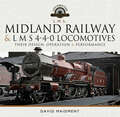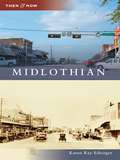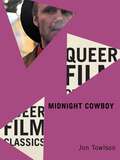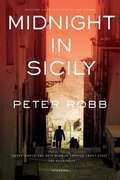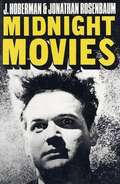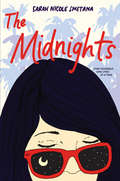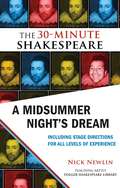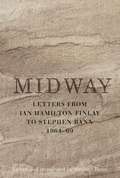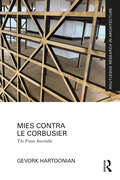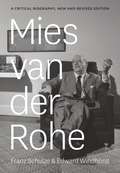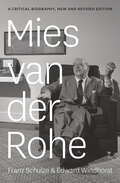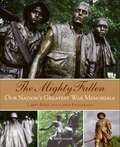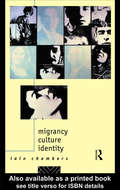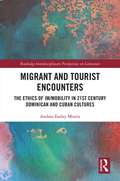- Table View
- List View
Middletown (Images of America)
by Charles Harbaugh Iv Jeff PenningtonMiddletown was established in 1797 by Peter Senseney as a tollhouse and tavern location along the Great Wagon Road. The town became notable primarily for the climactic Battle of Cedar Creek on October 19, 1864. Middletown is home to several important institutions, including the Wayside Inn, the oldest continuously operating inn in America, and the great Wayside Theater, which operated for 52 seasons and hosted prominent actresses like Susan Sarandon and Kathy Bates. Through vintage photographs ranging from the establishment of Virginia's first agricultural high school to the inception of Lord Fairfax Community College, which developed from humble beginnings into one of the fastest-growing colleges in the state, Middletown is a visual celebration of a community that has blossomed into a picturesque town.
Middletown and Unionville Railroad
by Douglas BarberioThe Middletown and Unionville Railroad, successor to the Middletown, Unionville and Water Gap Railroad, operated from December 1, 1913, until May 31, 1946, when it was reorganized as the Middletown and New Jersey Railway. The railroad's main revenue was derived from the transportation of dairy products, feed, coal, lumber, and passengers along its 14.5-mile right-of-way from the city of Middletown through Slate Hill, Johnson, Westtown, and Unionville in Orange County, New York. It provided a connection between the Erie Railroad in Middletown; the New York, Ontario & Western Railway in Middletown; and the New York, Susquehanna & Western Railroad in New Jersey. All three of these railroads had unique relationships with the M&U during its period of operation.
Middletown Borough
by Edward William Sunbery David Ira KaganMiddletown was settled in 1752, when George Fisher arrived from Philadelphia and built a home on the west bank of Swatara Creek. Named Middletown because it was midway between Lancaster and Carlisle, this oldest town in Dauphin County became incorporated as a borough in 1826. Through the years Middletown became noted for its Wincroft Stove Works, Standard Steel Car Company, Middletown-Royalton Brick Works, and Rough Wear Clothing Company. During World War II, Olmsted Air Force Base added greatly to the town's economy. In 1979, the Three Mile Island nuclear incident assured that Middletown would be known to the rest of the world.
Middletown Pacemakers: The Story of an Ohio Hot Rod Club (Images of America)
by Ron RobersonHot Rodding began in Southern California in the 1930s and had spread throughout the United States by the mid 1950s, spawning the sport of drag racing and the advent of the Detroit "muscle cars" of the '60s and '70s. Hot Rod Magazine and the National Hot Rod Association promoted the formation of responsible car clubs to combat the delinquent reputation of hot rodders, earned through illegal street races and Hollywood's portrayal in "B" movies. And thus were born the Middletown Pacemakers in 1951.The Pacemakers brought southern Ohio its first reliability runs (1952), custom auto shows (1954), and drag racing competitions-setting national records (1958, '63, '64) and winning national championships (1963, '64, '65). When the hot rodders were not busy upgrading their drive train for more horsepower or "chopping" and "channeling" for improved performance, they could often be seen on the streets of Middletown feeding expired parking meters or rescuing motorists whose cars had broken down or run out of gas. By 1966, as was the fate of so many hot rod clubs, the mass production of Detroit muscle cars ushered the Pacemakers to fold.
Middletown Revisited
by Marvin H. CohenLocated in the lower Hudson Valley, Middletown was first settled in 1760 and quickly grew into a thriving dairy farming center. With the arrival of the pioneering New York and Erie Rail Road in 1843, Middletown continued to flourish, and by 1888, it became a city. Hundreds of residents found employment in the growing railroad industry as well as at the sprawling Middletown State Hospital, with its advanced facilities at one time boasting over 100 buildings. Middletown Revisited documents the rich history of a city that has continued to grow over generations.
Midkemia: The Chronicles of Pug
by Raymond E. FeistThe world of Raymond E. Feist is brought to stunning life in this illustrated deluxe compendium, complete with maps, character drawings, and first-person narrative text by the master of fantasy fiction. Part travel log/journal and part atlas, Midkemia: The Chronicles of Pug brings the fictional world of Midkemia to vivid, illustrative life, and gives readers a completely new look at the creative genius of Raymond E. Feist. Written in first-person--a first for veteran bestseller Raymond Feist--the book details the life and times of Pug of Stardock, the hero of Feist's The Chaoswar Trilogy. Beautiful hand-drawn maps illustrate the changes in Midkemia's geography as war ravages the land and physically alters the landscape; dedicated readers and fans can literally trace the changes made by each battle. Complete with thirty pieces of specially commissioned artwork, this book is a totally immersive look into the world of Midkemia as never experienced before.
Midland
by James CollettOn the southern edge of the vast Llano Estacado, Midland began as a midpoint along the Texas and Pacific Railway. From its earliest days, entrepreneurs like the Scharbauers and Henry Halff built a city based upon their dreams. Land speculators, ranchers, farmers, financiers, oilmen, investors, and engineers each placed their own unique brands on Midland's landscape. Over time, the community earned a variety of nicknames--Windmill Town, Land of the High Sky, and Tall City, among them. Although seemingly remote, Midland has regularly gained attention at the state, national, and even international level in areas as diverse as airplanes (Texas's first), cattle ranching, and as the home of George W. Bush. Midland's story is an American tale of a successful small city.
Midland (Postcard History Series)
by James Collett Doug PageMidland was a young farming and ranching community on the southern edge of the Llano Estacado when the real-photo postcard era began near the opening of the 20th century. Businesses, residents, and promoters embraced this new technology to produce images capturing Midland's unusual rural-and-cosmopolitan mix. As postcards changed to linen and chrome, Midland also underwent dramatic changes. The city on the plains worked hard to become an indispensable part of the vast 1920s Permian Basin oil industry. In post-World War II years, Midland grew into an urban center of West Texas, positioned strategically at the midpoint of Interstate 20's path from Fort Worth to El Paso.
Midland: Her Continuing Story (Images of America)
by Virginia Florey Leona SeamsterOnce a small settlement at the junction of the Tittabawassee and Chippewa Rivers, Midland began as a humble community and grew to become a testament to industrialization. Settlers populated the city and ambitiously founded a tiny lumbering village, which soon developed into a regional hub of the lumbering industry. Nearly a century after it was settled, Midland County experienced an oil boom, and consequently became the state's leader in oil production, bringing prosperity and further industrialization to the area.In their previous book, Midland: The Way We Were, Virginia Florey and Leona Seamster documented the significant people and places that have shaped Midland's rich history. In their second installment, Midland: Her Continuing Story, they have included the history of neighboring towns-Averill, Sanford, Coleman, Hope, and Edenville-that played a significant role in the lumbering era. Through nearly 200 historical photographs and a collection of unprecedented personal stories, Florey and Seamster again explore this fascinating region and focus on its proud heritage as an industrial leader.
Midland: The Way We Were (Images of America)
by Virginia Florey Leona SeamsterMidland, Michigan began life as The Forks, where the Tittabwassee and Chippewa Rivers met. By 1858, The Forks became the Village of Midland, and in 1869 it was incorporated and named the Village of Midland City. Lumbering and farmland attracted the first settlers, and in 1897 a brash young man named Herbert Henry Dow persuaded 57 investors to start a new business there named the Dow Chemical Company. Midland, by then a city, was forever changed.Included in Midland: The Way We Were are photographs that span the first 100 years of the city. From Main Street landmarks such as the Frolic Theater, to the churches and schools where Midland's residents worshiped and learned-here are over 200 images detailing Midland's history.
Midland Railway and L M S 4-4-0 Locomotives: Their Design, Operation and Performance
by David MaidmentDavid Maidment has unravelled the complex history of the Johnson, Deeley and Fowler 4-4-0 locomotives of the Midland Railway and its LMS successor, covering their design, construction, operation and performance in this book with over 400 black and white photographs. It recounts their working on the Midland main lines from St Pancras to Derby, Manchester, Leeds and Carlisle, the latter via the celebrated Settle & Carlisle line, and the later work of the Fowler LMS engines on the West Coast main line. The book also describes the history of the Midland 4-4-0s built for the Somerset & Dorset and Midland & Great Northern Railways. The book covers the period from the first Midland 4-4-0 built in 1876 to the last LMS 2P withdrawn in 1962 and includes performance logs, weight diagrams and dimensions and statistical details of each locomotive.
Midlothian (Then and Now)
by Karen Kay EsbergerBefore becoming an incorporated town in 1888, Midlothian was a farming community. Once the railroads arrived in 1882 and 1886, cotton production became an essential crop for the area. In the 1960s, cement production developed into the key industry because of the natural limestone chalk and shale formation in the area.
Midnight Cowboy (Queer Film Classics)
by Jon TowlsonMidnight Cowboy – the story of a small-town stud’s attempt to make it big as a hustler on the streets of 1960s New York – is an indisputably iconic film. Though recognized in terms of its early adoption of Nouvelle Vague cinematography and editing techniques, and renowned for an Oscar win in spite of controversy over its X-rating, Midnight Cowboy has yet to be understood as a classic of queer cinema.Jon Towlson reclaims Midnight Cowboy as a queer text by addressing John Schlesinger as a gay author and filmmaker and providing a fresh perspective on the film’s relationship to the 1965 James Leo Herlihy novel from which it was adapted. Offering a nuanced and personal view of the film’s relevance to queer experience and queer friendship, Towlson also considers Midnight Cowboy’s production and reception and its place in Schlesinger’s filmography. Depictions of sixties New York counterculture and 42nd Street hustlers offer an opportunity for reassessment, particularly in the film's relationship to male prostitution, male relationships, and sexual identity.By shifting the perspective away from previous interpretations of Midnight Cowboy as homophobic and problematic, Towlson argues for a new interpretation of the film as a proto-queer buddy movie and a critical forerunner to films such as My Own Private Idaho and Brokeback Mountain.
Midnight in Sicily
by Peter RobbSouth of mainland Italy lies the island of Sicily, home to an ancient culture that--with its stark landscapes, glorious coastlines, and extraordinary treasure troves of art and archeology--has seduced travelers for centuries. But at the heart of the island's rare beauty is a network of violence and corruption that reaches into every corner of Sicilian life: Cosa Nostra, the Mafia. Peter Robb lived in southern Italy for over fourteen years and recounts its sensuous pleasures, its literature, politics, art, and crimes.
Midnight Movies
by J. Hoberman Jonathan RosenbaumMidnight Movies is a comprehensive and in-depth look at over 100 subculture movies of the past three decades. It discusses the complete history of cult films, their makers, and their audience and what keeps audiences coming back to see them over and over again.
The Midnights
by Sarah Nicole SmetanaThis voice-driven coming-of-age YA novel is perfect for fans of Katie Cotugno and Playlist for the Dead.Susannah Hayes has never been in the spotlight, but she dreams of following her father, a former rock star, onto the stage. As senior year begins, she’s more interested in composing impressive chord patterns than college essays, certain that if she writes the perfect song, her father might finally look up from the past long enough to see her. But when he dies unexpectedly, her dreams—and her reality—shatter.While Susannah struggles with grief, her mother uproots them to a new city. There, Susannah realizes she can reinvent herself however she wants: a confident singer-songwriter, member of a hip band, embraced by an effortlessly cool best friend. But Susannah is not the only one keeping secrets, and soon, harsh revelations threaten to unravel her life once again.Set against the scintillating landscape of Southern California, The Midnights is an evocative coming-of-age debut about loss, creativity, and finding your voice while you’re still finding yourself.
A Midsummer Night's Dream: The 30-Minute Shakespeare
by Nick NewlinPlanning a school or amateur Shakespeare production? The best way to experience the plays is to perform them, but getting started can be a challenge: The complete plays are too long and complex, while scene selections or simplified language are too limited."The 30-Minute Shakespeare" is a new series of abridgements that tell the "story" of each play from start to finish while keeping the beauty of Shakespeare's language intact. Specific stage directions and character suggestions give even inexperienced actors the tools to perform Shakespeare with confidence, understanding, and fun!This cutting focuses on three ridiculously funny and vibrant scenes from A MIDSUMMER NIGHT'S DREAM. The first scene starts with Puck mistakenly anointing the eyes of the wrong lovers with love potion, leading to a madcap chase scene between Helena, Lysander, Hermia, and Demetrius. Scene two features Bottom's magical transformation to an ass, always an audience favorite. The final scene is the classic play within a play, where the "Rude Mechanicals" act out with "tragical mirth" the story of Pyramus and Thisbe, with specific comic suggestions for the characters, including Lion chasing Thisbe into the audience!The edition also includes an essay by editor Nick Newlin on how to produce a Shakespeare play with novice actors, and notes about the original production of this abridgement at the Folger Shakespeare Library's annual Student Shakespeare Festival.
Midway
by Stephen Bann Ian Hamilton FinlayIan Hamilton Finlay (1925-2006) was one of Scotland's leading twentieth-century public intellectuals, and famously one of its most brilliant and combative correspondents. His letters raise issues of particular and widespread interest both within Scotland and further afield. His correspondence with Stephen Bann, the English poet and academic, have a very special place in this context. These letters present in a clear and commensurable form the development of his ideas about poetry and art, and increasingly about sculpture and gardening, over this critical five-year period of his creative life.The letters begin when Bann was still a student at Cambridge, and Finlay was living in considerable hardship in Edinburgh, though he already had a significant international reputation as a poet. They reveal in fascinating and intimate detail the poet's developing creative process, and also record his often turbulent relationship to the worlds of literature, art, and critical journalism. When he settles in Lanarkshire, he begins to develop the ideas that will result in the creation of the world-famous sculpture garden known as Little Sparta.This book, edited, introduced, and annotated by Bann himself, is a unique and compelling self-portrait of the man who is now recognized not only as a great poet, but also as a major artist and one of the most original garden designers of modern times.Stephen Bann is a poet, historian, and cultural critic. He is an emeritus professor of the history of art at Bristol University, and the author of numerous books and articles.
Mies at Home: From Am Karlsbad 24 to the Tugendhat House (Routledge Research in Architecture)
by Xiangnan XiongMies at Home is a radical rereading of one of the most significant periods in Mies van der Rohe’s career, from the mid- to late 1920s when he was developing his seminal spatial ideas— ideas that would culminate in his celebrated design of the Tugendhat House. The book examines how Mies’s experience of residing in his apartment, doubling as a studio, in central Berlin had an impact on his spatial concepts. It uncovers one of the most profound but virtually untold aspects of Mies’s development: how his visions of an ideal lifestyle came out of his own living experience and how they, in turn, informed his domestic architecture. Mies’s quest featured two breakthroughs. In the Weissenhof apartment building, he conveyed a flexible and manifold lifestyle that many of the avant-garde artists, including himself, were practicing. Later, in the Tugendhat House, he put forward an alternative way of living that centered on contemplation. Beautifully illustrated throughout, Mies at Home offers a fresh investigation of the diverse intentions and strategies the architect used in creating his iconic open spaces. It will be an insightful read for researchers, academics, and students in architectural history and theory.
Mies Contra Le Corbusier: The Frame Inevitable (Routledge Research in Architecture)
by Gevork HartoonianIn Mies Contra Le Corbusier, Gevork Hartoonian embarks on a captivating exploration of the architectural ideologies embodied in the works of Mies van der Rohe and Le Corbusier.Focusing on the non-synchronicity inherent in their approaches to the tectonics of the column and wall, Hartoonian conducts a comparative analysis of carefully selected diachronic projects from each architect. This insightful journey unravels the architects' ideological stances within the ongoing dialogue between modernity and tradition. Hartoonian sheds light on the inclination of Mies and Le Corbusier toward a frameless architecture, a characteristic prominently displayed in their late works. Drawing inspiration from Marxian philosophy, the author contends that significant technological developments play a crucial role in shaping subjectivities across the cultural spectrum, creating an uneven dissemination. The frame, in Hartoonian’s lens, transcends the boundaries of a single building, becoming a lens through which to frame a nuanced understanding of the urban landscape and tectonics. Mies Contra Le Corbusier stands as a thought-provoking exploration that not only unveils the intricacies of architectural history but also offers profound insights into the cultural and technological forces shaping the built environment.This book will be of interest to researchers and students of architectural history and theory. Additionally, it offers a timely discussion of Mies and Le Corbusier’s contributions to architecture’s contemporaneity for the younger generation of architects.
Mies van der Rohe: A Critical Biography, New and Revised Edition
by Franz Schulze Edward WindhorstMies van der Rohe: A Critical Biography is a major rewriting and expansion of Franz Schulze’s acclaimed 1985 biography, the first full treatment of the master German-American modern architect. Coauthored with architect Edward Windhorst, this revised edition, three times the length of the original text, features extensive new research and commentary and draws on the best recent work of American and German scholars. The authors’ major new discoveries include the massive transcript of the early-1950s Farnsworth House court case, which discloses for the first time the facts about Mies’s epic battle with his client Edith Farnsworth. Giving voice to dozens of architects who knew and worked with (and sometimes against) Mies, this comprehensive biography tells the compelling story of how Mies and his students and followers created some of the most significant buildings of the twentieth century.
Mies van der Rohe: A Critical Biography, New and Revised Edition (Illustrated Catalog Of The Mies Van Der Rohe Drawing In The Museum Of Modern Art Ser. #Pt. Ii, 1938-1967, The American Work)
by Franz Schulze Edward WindhorstAn &“excellent&” new edition of the definitive biography of the architectural genius, with more than a hundred photos (Booklist, starred review). Upon publication, this book was praised by the Chicago Tribune and &“the most comprehensive book ever written about the master designer and, by any measure, the best,&” while the Christian Science Monitor noted that &“Schulze has both the gift of an architectural historian able to render Mies&’s building innovations and that of a biographer able to paint the humanity and shortcomings of the man.&” Newsweek called it &“a revelation.&” Now, this biography of the iconic modernist architect and designer has been extensively updated, providing an even more enlightening and intimate portrait of a man who helped to create the twentieth century world. &“This excellent revised edition…has 138 illustrations, incisive descriptions of Mies&’ innovative creations and a fascinating account of his Pyrrhic victory in a lawsuit against his disaffected client Edith Farnsworth.&”—Booklist (starred review) &“This authoritative biography of Mies van der Rohe has been updated through building records, the recollections of students and a court transcript. It's a gripping read.&”—Christopher Woodward, Building Design
The Mighty Fallen: American War Memorials
by Larry Bond f-stop FitzgeraldThe Mighty Fallen is a beautiful, evocative presentation of more than 150 never-before-seen photographs of the nation's greatest monuments and war memorials, along with text that describes the memorials and tells their stories. This extraordinary collection calls attention to the power of memory and the ways in which we immortalize people and events. As Larry Bond notes in the Introduction, "Memories of a war or battle are unpleasant, but few veterans would want them erased." This book is a unique tribute to veterans and a commemoration of some of the most significant conflicts in our history. Most battlefields leave little record of the historic confrontations that occurred there. Those who fought in epic struggles want us to remember not just the outcome, but the cost of victory and those who paid the price for the freedoms we enjoy today. Memories fade, so we raise monuments of stone and bronze to carry their message of sacrifice through the centuries. The Iwo Jima Memorial and the Vietnam Veterans Memorial in Washington DC are instantly recognizable, but there are monuments all over North America honoring more than 300 years of military service. The Mighty Fallen shows you hundreds of monuments, memorials, and statues conveying the message their designers wanted you to hear—these are more than just a date and location.
Migrancy, Culture, Identity (Comedia)
by Iain ChambersIn Migrancy, Culture, Identity, Iain Chambers unravels how our sense of place and identity is realised as we move through myriad languages, worlds and histories. The author explores the uncharted impact of cultural diversity on today's world, from the 'realistic' eye of the painter to the 'scientific' approach of the cultural anthropologist or the critical distance of the historian; from the computer screen to the Walkman and 'World Music'. Migrancy, Culture and Identity takes us on a journey into the disturbance and dislocation of culture and identity that faces all of us to explore how migration, marginality and homelessness have disrupted the West's faith in linear progress and rational thinking, undermining our knowledge, history and cultural identity.
Migrant and Tourist Encounters: The Ethics of Im/mobility in 21st Century Dominican and Cuban Cultures (Routledge Interdisciplinary Perspectives on Literature)
by Andrea Easley MorrisMigrant and Tourist Encounters: The Ethics of Im/mobility in 21st Century Dominican and Cuban Cultures analyzes the effects of clashing flows of voluntary and involuntary travelers to and from these countries due to an increase in migration and tourism during the last three decades. I compare the ways in which literary works and films reflect on and critique the power relations and ethics of im/mobility and encounter, both on the islands and in destinations abroad. The works draw attention to the interconnectedness of migration, tourism, and other forms of travel as well as immobility, and portray growing local and global inequalities through characters’ disparate access to free, voluntary movement. I consider how the works respond to the question of the moral potential of encounters produced by im/mobilities and the possibility of connection across differences. I argue that Dominican and Cuban artists not only critique neo-colonial paradigms of power and im/mobility, but envision and enact strategies for belonging and, in some cases, suggest a path toward de-colonial cosmopolitanism.
